The artist Alice Aycock has had a couple of big years recently. Among other things, two prestigious institutions, NYU's Grey Art Gallery and the Parrish Art Museum simultaneously shared halves of a large retrospective of her drawings. The reaction to the depth, breadth and scope of the work was a kind of astonishment. It was clear from the brilliant survey, that Alice was someone who had it all from the beginning.
Utterly beguiling in a video interview done in 1977 (shown with the early work at the Grey), Alice—looking too young for what came out of her mouth—intoned the most sophisticated and well thought out aesthetic philosophy imaginable. The video stands today as a record of her incredibly precocious self-awareness as an artist.
.
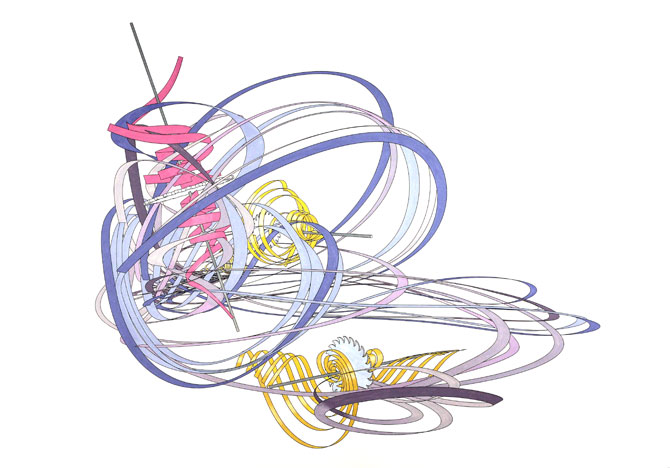
From the Series Entitled, "Sum Over Histories": Study for a Timescape by Alice Aycock, 2011. Ink and watercolor on paper, 50 x 72 inches. Collection of the Artist; Courtesy of Galerie Thomas Schulte, Berlin. Exhibited at the Parrish Art Museum.
.
As a young student, she had intended a literary career when she encountered the site-specific installations being made by artists in the 1960s. Seeing those, Alice said she knew immediately what she wanted to do and changed directions at once.
At Hunter College, where she was enrolled, it was fortuitous the college had just the faculty to help guide her: art scholar Gene Goossen and crew. Since its inception, her work has combined her initial literary predilections with architectonic forms sited in mostly public spaces. She said she was inspired by Jorge Luis Borges' story, “The Aleph,” which deals with the concept of one point in space that contains all points in the universe simultaneously.
Alice's first works, having brilliantly usurped architectural space and form as a vehicle for narrative or metaphor, established her as a serious contender in a predominantly male genre that included the likes of Serra, Andre, Oppenheim, Matta-Clark, Smithson, Turrell and others. She has had a spectacular career ever since, exploring all the extensions of the two roots of her artistic expression.
I think of myself as very lucky to have gotten to know Alice as a friend during the last decade, and have had the chance to converse with her on many a deep subject. It has been a particular pleasure to watch the blooming of her latest project: “Park Avenue Paper Chase.” The project is her response to the 2012 invitation from the Fund for Park Avenue to present site specific work along Park from 52nd to 57th street, a hallowed venue that has been the site for works by the likes of Henry Moore, among others.
During the weeks that “Park Avenue Paper Chase” was installed, art lovers were treated to seven works that together comprised the uber work. In ascending order they were: Maelstrom, 2014, painted aluminum, 12' high by 16' wide by 67' long, between 52nd and 53rd;
.
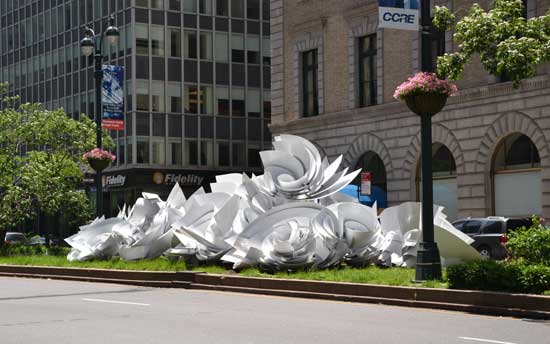
"Maelstrom" by Alice Aycock, 2014. Painted aluminum, 12 x 16 x 67 feet.
.
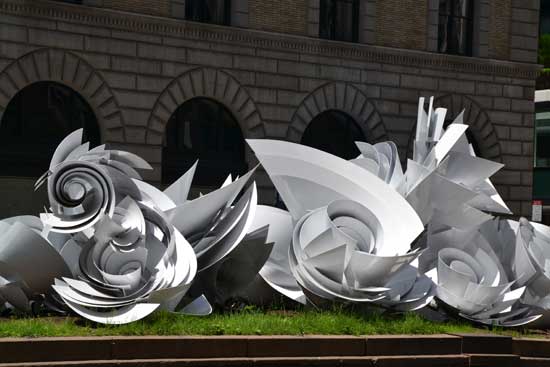
Detail of "Maelstrom" by Alice Aycock, 2014. Painted aluminum, 12 x 16 x 67 feet.
.
Hoop-La, 2014, painted aluminum and steel, 19' high by 17' wide by 24' long, at 53rd Street;
.

"Hoop-La" by Alice Aycock, 2014. Painted aluminum and steel, 19 x 17 x 24 feet.
.
Twin Vortexes, 2014, painted aluminum, 12' high by 12' wide by 18' long, at 54th Street;
.

"Twin Vortexes" by Alice Aycock, 2014. Painted aluminum, 12 x 12 x 18 feet.
.
Spin-the-Spin, 2014, painted aluminum, 18' high by 15' wide by 20' long, at 55th Street;
.
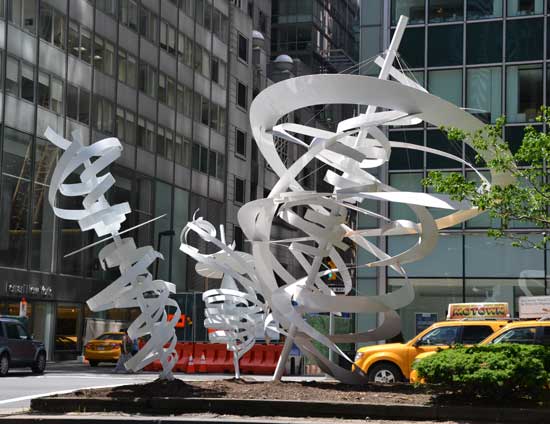
"Spin-the-Spin" by Alice Aycock, 2014. Painted aluminum, 18 x 15 x 20 feet.
.
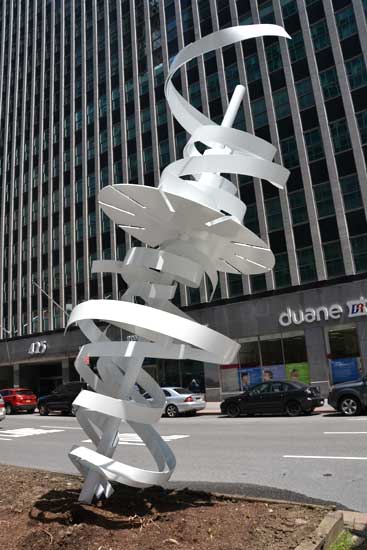
Detail of "Spin-the-Spin" by Alice Aycock, 2014. Painted aluminum, 18 x 15 x 20 feet.
.
Waltzing Matilda, 2014, reinforced fiberglass, 15' high by 15' wide by 18' long, at 56th Street;
.
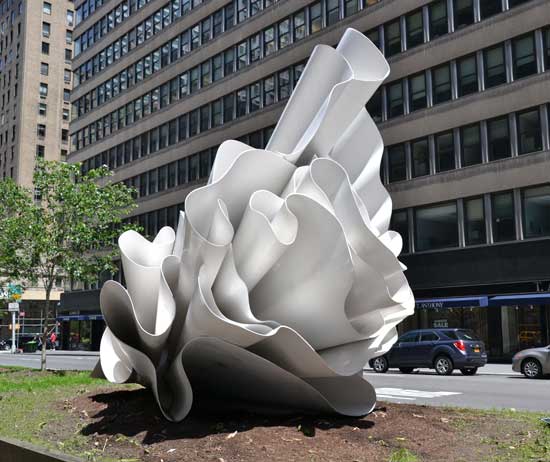
"Waltzing Matilda" by Alice Aycock, 2014. Reinforced fiberglass, 15 x 15 x 18 feet.
.
Cyclone Twist, 2013, painted aluminum, 27' high by 15' diameter, at 57th Street;
.

"Cyclone Twist" by Alice Aycock, 2013. Painted aluminum, 27 x 15 (diameter) feet.
.
and Twister, 2014, painted aluminum and steel, approximately 12’ high by 11' wide by 12’ long, at 66th Street.
Alice has described her intentions with the project in this way: "I wanted the work to have a random haphazard quality—in some cases piling up on itself, in others spinning off into the air. Much of the energy is invisible. It is the energy of thought and ideas colliding and being transmitted outward."
What I would add is this: Though others have done and are doing works made through use of the computer, Alice has really utilized its special capacities.
She first developed a deep repertoire of forms based on cyclonic wind patterns, among other things, which she has said allude to thoughts and ideas becoming energized and visualized. She has since been able to manifest the complexity of these forms aided by the design ability of 3D CAD programs. The software enables her to map and diagram the form and create the blueprints for fabrication.
The many facets of the interstitial vortexes she has conceived could only be coordinated through the memory of the computer. So, unlike a lot of computer based art, which simply imitates hand made art in the digital domain and thus has no real proprietary relevance, the work Alice is creating justifies the computer as an essential and irreplaceable tool in realizing her vision.
The forms of the seven works of "Park Avenue Paper Chase" certainly have a chaotic, haphazard, and chance-driven vibe, and yet to conceive of these kinds of forms required a process absolutely the opposite of what they suggest. This is the magic of her art.
I am reminded of a statement by the Abstract Expressionist painter James Brooks, who once said he wanted to "absorb" the accident. Alice has absorbed the chaos, the turbulence of internal, invisible storms. The working of her unique mind demonstrates how she's mapped her way through the labyrinth of the random, which requires a state of detachment and objectivity. All of which is to say, she is able to maintain a state of awakened neutrality. And that's the feeling, too, and why these works are elegant and not brutal. By accepting the unpredictable, she is able to understand it, thus converting the tornado into a flower, the hurricane into a lyrical arabesque.
It is this quality too that makes the work feel light and enjoyable to view. We can see into the beauty of the convoluted forms, the boiling of energy, its breaking apart, entwining again and wrapping in on itself, intermingling again, knotting and fraying and flailing. All along the avenue the giant white tumbling sculptures are nothing more nor less than the visual poetry of ebb and flow.
That's the feeling they convey, even though they are quite large in scale. Their always curving, ribbony language works as a counterpoint against the city's structure—the stiff vertical and horizontal grid, and as they appear here and there, as it were, as one encounters them, they are as the artist conceived: like delicate sheets of paper blowing through a canyon on their way to infinity.
While the installation just closed last week, there will be a life for all the pieces after Park Avenue. According to the artist: "The work on 66th Street (Twister) and on 57th (Cyclone Twist) are going to private collectors. Waltzing Matilda (at 56th Street), Spin-the-Spin (55th Street) and Twin Vortexes (54th Street) are going to Chicago to be exhibited on Lakeshore Drive during and after Expo Chicago. Hoop-La (on 53rd Street) is going to Chatsworth, England (Sotheby's Sculpture Park). This is not at auction but for exhibition and sale."
_______________________
BASIC FACTS: "Park Avenue Paper Chase" by Alice Aycock was installed from March 2014 through late July 2014 in New York City between 52nd and 57th Streets and at 66th Street on Park Avenue. www.aaycock.com.
RELATED: "'Alice' Touches Down at LongHouse" by Mike Solomon. Published August 12, 2013.
"Art Review – The Taming of Fantastical Worlds: Drawings by Alice Aycock" by Esperanza Leon. Published May 17, 2013.
_______________________
Copyright 2014 Hamptons Art Hub LLC. All rights reserved.
